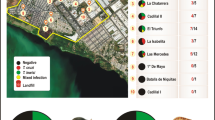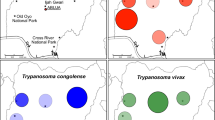Abstract
Trypanosoma lewisi (Kinetoplastea: Trypanosomatida: Trypanosomatidae) with a cosmopolitan distribution is the type species of the subgenus Herpetosoma, which includes ca. 50 nominal species isolated mainly from rodents. Since members of Herpetosoma in different host species have an almost identical morphology of bloodstream forms, these trypanosomes are referred to as ‘T. lewisi-like’, and the molecular genetic characterization of each species is necessary to verify their taxonomy. In the present study, we collected blood samples from 89 murid rodents of 15 species and 11 soricids of four species in Indonesia, Philippines, Vietnam, Taiwan, and mainland China for the detection of hemoprotozoan infection. T. lewisi and T. lewisi-like trypanosomes were found in the blood smears of 10 murid animals, which included Bandicota indica (two rats), Rattus argentiventer (one rat), and Rattus tiomanicus (two rats) in Indonesia; Rattus rattus (one rat) in the Philippines; and Niviventer confucianus (four rats) in mainland China. Furthermore, large- or medium-sized non-T. lewisi-like trypanosomes were detected in two soricids, Crocidura dracula in Vietnam and Anourosorex yamashinai in Taiwan, respectively. Molecular genetic characterization of the small subunit (SSU) ribosomal RNA gene (rDNA) and glycosomal glyceraldehyde-3-phosphate dehydrogenase (gGAPDH) gene indicated that the trypanosomes from all the murid hosts had identical SSU rDNA or gGAPDH gene nucleotide sequences except for those in N. confucianus in mainland China. These N. confucianus-infecting trypanosomes also showed several unique morphological features such as smaller bodies, anteriorly positioned nuclei, and larger rod-shaped kinetoplasts when compared with T. lewisi trypomastigotes. Trypanosoma (Herpetosoma) niviventerae n. sp. is erected for this new species. Similarly, based on morphological and molecular genetic characterization, Trypanosoma sapaensis n. sp. and Trypanosoma anourosoricis n. sp. are proposed for the trypanosomes in C. dracula in Vietnam and A. yamashinai in Taiwan, respectively. More effort directed toward the morphological and molecular genetic characterization of the trypanosomes of rodents and soricids is required to fully understand the real biodiversity of their hemoflagellates.




Similar content being viewed by others
References
Abramov AV, Bannikova AA, Rozhnov VV (2012) White-toothed shrews (Mammalia, Soricomorpha, Crocidura) of coastal islands of Vietnam. ZooKeys 2007:37–47
Anisimova M, Gascuel O (2006) Approximate likelihood-ratio test for branches: a fast, accurate, and powerful alternative. Syst Biol 55:539–552
Bardsley JE, Harmsen R (1973) The trypanosomes of anura. Adv Parasitol 11:1–73
Cooper C, Clode PL, Peacock C, Thompson RCA (2017) Host–parasite relationships and life histories of trypanosomes in Australia. Adv Parasitol 97:47–109
Davis BS (1952) Studies on the trypanosomes of some California mammals. University of California Publications in Zoology 57:145–249
Davis BS (1969) Trypanosoma (Megatrypanum) hoarei sp. nov. (Prozoa: Trypanosomatidae) from shrews of the genus Sorex in California. Parasitology 59:469–491
Dereeper A, Guignon V, Blanc G, Audic S, Buffet S, Chevenet F, Dufayard JF, Guindon S, Lefort V, Lescot M, Claverie JM, Gascuel O (2008) Phylogeny.fr: robust phylogenetic analysis for the non-specialist. Nucleic Acids Res 36:465–469
Guan G, Niu Q, Yang J, Li Y, Gao J, Luo J, Yin H (2011) Trypanosoma (Herpetosoma) grosi: first isolation from Chinese striped field mouse (Apodemus agrarius). Parasitol Int 60:101–104
Guindon S, Gascuel O (2003) A simple, fast, and accurate algorithm to estimate large phylogenies by maximum likelihood. Syst Biol 52:696–704
Haag J, O’hUigin C, Overath P (1998) The molecular phylogeny of trypanosomes: evidence for an early divergence of the Salivaria. Mol Biochem Parasitol 91:37–49
Hamilton PB, Stevens JR, Gaunt MW Gidley J, Gibson WC (2004) Trypanosomes are monophyletic: evidence from genes for glyceraldehyde phosphate dehydrogenase and small subunit ribosomal RNA. Int J Parasitol 34:1393–1404
Hamilton PB, Stevens JR, Holz P, Boag B, Cooke B, Gibson WC (2005) The inadvertent introduction into Australia of Trypanosoma nabiasi, the trypanosome of the European rabbit (Oryctolagus cuniculus), and its potential for biocontrol. Mol Ecol 14:3167–3175
Hamilton PB, Gibson WC, Stevens JR (2007) Patterns of co-evolution between trypanosomes and their hosts deduced from ribosomal RNA and protein-coding gene phylogenies. Mol Phylogenet Evol 43:15–25
Hoare CA (1972) The trypanosomes of mammals. Blackwell Scientific, Oxford, p 749
Hong XK, Zhang X, Fusco OA, Lan YG, Lun ZR (2017) PCR-based identification of Trypanosoma lewisi and Trypanosoma musculi using maxicircle kinetoplast DNA. Acta Trop 171:207–212
Karbowiak G, Wita I, Rychlik L (2005) Trypanosoma (Megatrypanum) ornata sp. n., a parasite of the Eurasian water shrew Neomys fodiens (Pennant, 1771). Acta Protozool 44:363–367
Lun ZR, Wen YZ, Uzureau P, Lecordier L, Lai DH, Lan YG, Desquesnes M, Geng GQ, Yang TB, Zhou WL, Jannin JG, Simarro PP, Truc P, Vincendeau P, Pays E (2015) Resistance to normal human serum reveals Trypanosoma lewisi as an underestimated human pathogen. Mol Biochem Parasitol 199:58–61
Ma Y, Wang F, Jin S, Li S (1987) Glires (rodents and lagomorphs) of northern Xinjiang and their zoogeographical distribution. Science Press, Beijing, p 274 (in Chinese)
Mafie E, Rupa FH, Setsuda A, Saito-Ito A, Sato H (2016) Brief review on atypical trypanosomiasis of Trypanosoma lewisi. Jpn J Vet Parasitol 15:24–33
Mafie E, Rupa FH, Takano A, Suzuki K, Maeda K, Sato H (2018) First record of Trypanosoma dionisii of the T. cruzi clade from the eastern bent-winged bat (Miniopterus fuliginosus). Parasitol Res 117:673–680
Maia da Silva F, Marcili A, Ortiz PA, Epiphanio S, Campaner M, Catão-Dias JL, Shaw JJ, Camargo EP, Teixeira MMG (2010) Phylogenetic, morphological and behavioural analyses support host switching of Trypanosoma (Herpetosoma) lewisi from domestic rats to primates. Inf Genet Evol 10:522–529
Noyes HA, Stevens JR, Teixeira M, Phelan J, Holz P (1999) A nested PCR for the ssrRNA gene detects Trypanosoma binneyi in the platypus and Trypanosoma sp. in wombats and kangaroos in Australia. Int J Prassitol 29:311–339 (Corrigendum: International Journal for Parasitology 30: 228 [2000])
Noyes HA, Ambrose P, Barker F, Begon M, Bennet M, Bown KJ, Kemp SJ (2002) Host specificity of Trypanosoma (Herpetosoma) species: evidence that bank voles (Clethrionomys glareolus) carry only one T. (H.) evotomys 18S rRNA genotype but wood mice (Apodemus sylvaticus) carry at least two polyphyletic parasites. Parasitology 124:185–190
Ortiz PA, Garcia HA, Lima L, Maia da Silva FM, Campaner M, Pereira CL, Jittapalapong S, Neves L, Desquesnes M, Camargo EP, Teixeira MMG (2018) Diagnosis and genetic analysis of the worldwide distributed Rattus-borne Trypanosoma (Herpetosoma) lewisi and its allied species in blood and fleas of rodents. Infect Genet Evol 63:380–390
Paparini A, Irwin PJ, Warren K, McInnes LM, de Tores P, Ryan UM (2011) Identification of novel trypanosome genotypes in native Australian marsupials. Vet Parasitol 183:21–30
Pérez-Morga D, Vanhollebeke B, Paturiaux-Hanocq F, Derek P, Nolan DP, Lins L, Homblé F, Vanhamme L, Tebabi P, Pays A, Poelvoorde P, Jacquet A, Brasseur R, Pays E (2005) Apolipoprotein L-I promotes trypanosome lysis by forming pores in lysosomal membranes. Science 309:469–472
Pumhom P, Pognon D, Yangtara S, Thaprathorn N, Milocco C, Douangboupha B, Herder S, Chaval Y, Morad S, Jittapalapong S, Desquesnes M (2014) Molecular prevalence of Trypanosoma spp. in wild rodents of Soureast Asia: influence of human settlement habitat. Epidemiol Infect 142:1221–1230
Sato H, Ishita K, Matsuo K, Inaba T, Kamiya H, Ito M (2003) Persistent infection of Mongolian jirds with a non-pathogenic trypanosome, Trypanosoma (Herpetosoma) grosi. Parasitology 127:357–363
Sato H, Osanai A, Kamiya H, Obara Y, Jiang W, Zhen Q, Chai J, Une Y, Ito M (2005) Characterization of SSU and LSU rRNA genes of three Trypanosoma (Herpetosoma) grosi isolates maintained in Mongolian jirds. Parasitology 130:157–167
Sato H, Al-Adhami BH, Une Y, Kamiya H (2007) Trypanosoma (Herpetosoma) kuseli sp. n. (Protozoa: Kinetoplastida) in Siberian flying squirrels (Pteromys Volans). Parasitol Res 101:453–461
Sato H, Leo N, Katakai Y, Takano J, Akari H, Nakamura S, Une Y (2008) Prevalence and molecular phylogenetic characterization of Trypanosoma (Megatrypanum) minasense in the peripheral blood of small Neotropical primates after a quarantine period. J Parasitol 94:1128–1138
Simpson AGB, Stevens JR, Lukeš J (2006) The evolution and diversity of kinetoplastid flagellates. Trends Parasitol 22:168–174
Stevens J, Noyes H, Gibson W (1998) The evolution of trypanosomes infecting humans and primates. Mem Inst Oswald Cruz 93:669–676
Thompson JD, Higgins DG, Gibson TJ (1994) CLUSTAL W: improving the sensitivity of progressive multiple sequence alignment through sequence weighting, positions-specific gap penalties and weight matrix choice. Nucleic Acids Res 22:4673–4680
Truc P, Büscher P, Cuny G, Gonzatti MI, Jannin J, Joshi P, Juyal P, Lun Z-R, Mattioli R, Pays E, Simarro PP, Teixeira MMG, Touatier L, Vincendeau P, Desquesnes M (2013) Atypical human infections by animal trypanosomes. PLoS Negl Trop Dis 7:e2256. https://doi.org/10.1371/journal.pntd.0002256
Vanhamme L, Paturiaux-Hanocq F, Poelvoorde P, Nolan DP, Lins L, Van Den Abbeele J, Pays A, Tebabi P, Van Xong H, Jacquet A, Moguilevsky N, Dieu M, Kane JP, De Baetseller P, Brasseur R, Pays E (2003) Apolipoprotein L-I is the trypanosome lytic factor of human serum. Nature 422:83–87
Zhang Y, Jin S, Quan G, Li S, Ye Z, Wang F, Zhang M (1997) Distribution of mammalian species in China. China Forestry Publishing House, Beijing, p 280
Zhang LL, Ni QX, Yao LN, Zhang XH, Chen HL, Feng Y, Zhang X, Yu KG, Ruan W (2015) [Identification of Trypanosoma species in Rattus flavipectus and R. losea using microscopy and PCR method]. Zhongguo Ji Sheng Chong Xye Yu Ji Sheng Chong Bing Za Zi (Chin J Parasitol Parasit Dis) 33:277–280
Acknowledgments
We are indebted to the mammalogists of Hasanuddin University, Indonesia, and Central Luzon State University, Philippines, for their species identification of the collected murids and soricids.
Author information
Authors and Affiliations
Corresponding author
Ethics declarations
The ethics of animal trapping and sample collection adhered to in this study followed the guidelines outlined by each survey participant’s university, but at that time, no individual permission numbers of sample collection were provided to us from these organizations.
Conflict of interest
The authors declare that they have no conflict of interest.
Additional information
Section Editor: Marta Teixeira
Rights and permissions
About this article
Cite this article
Mafie, E., Saito-Ito, A., Kasai, M. et al. Integrative taxonomic approach of trypanosomes in the blood of rodents and soricids in Asian countries, with the description of three new species. Parasitol Res 118, 97–109 (2019). https://doi.org/10.1007/s00436-018-6120-3
Received:
Accepted:
Published:
Issue Date:
DOI: https://doi.org/10.1007/s00436-018-6120-3




